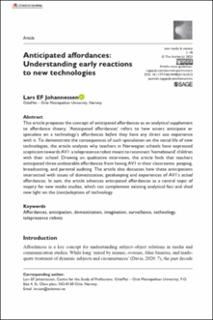| dc.contributor.author | Johannessen, Lars E. F. | |
| dc.date.accessioned | 2023-07-06T12:04:26Z | |
| dc.date.available | 2023-07-06T12:04:26Z | |
| dc.date.created | 2023-05-06T08:38:56Z | |
| dc.date.issued | 2023 | |
| dc.identifier.issn | 1461-4448 | |
| dc.identifier.uri | https://hdl.handle.net/11250/3076604 | |
| dc.description.abstract | This article proposes the concept of anticipated affordances as an analytical supplement to affordance theory. ‘Anticipated affordances’ refers to how actors anticipate or speculate on a technology’s affordances before they have any direct use experience with it. To demonstrate the consequences of such speculation on the social life of new technologies, the article analyses why teachers in Norwegian schools have expressed scepticism towards AV1: a telepresence robot meant to reconnect ‘homebound’ children with their school. Drawing on qualitative interviews, the article finds that teachers anticipated three undesirable affordances from having AV1 in their classrooms: peeping, broadcasting, and parental auditing. The article also discusses how these anticipations intersected with issues of domestication, gatekeeping and experiences of AV1’s actual affordances. In sum, the article advances anticipated affordances as a central topic of inquiry for new media studies, which can complement existing analytical foci and shed new light on the (non)adoption of technology. | en_US |
| dc.language.iso | eng | en_US |
| dc.rights | Navngivelse-Ikkekommersiell 4.0 Internasjonal | * |
| dc.rights.uri | http://creativecommons.org/licenses/by-nc/4.0/deed.no | * |
| dc.title | Anticipated affordances: Understanding early reactions to new technologies | en_US |
| dc.type | Journal article | en_US |
| dc.type | Peer reviewed | en_US |
| dc.description.version | publishedVersion | en_US |
| cristin.ispublished | true | |
| cristin.fulltext | original | |
| cristin.qualitycode | 2 | |
| dc.identifier.doi | 10.1177/14614448231161512 | |
| dc.identifier.cristin | 2145927 | |
| dc.source.journal | New Media & Society | en_US |

